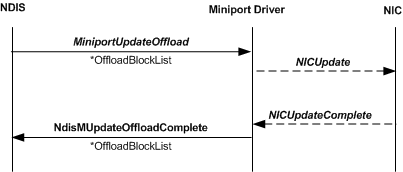Update Offload Sequence
[The TCP chimney offload feature is deprecated and should not be used.]
The following figure shows the call sequence for an update offload operation.

To update one or more offloaded variables, NDIS calls the offload target's MiniportUpdateOffload function. The MiniportUpdateOffload function inputs the following parameters:
A handle in the MiniportAdapterContext parameter that references the adapter instance.
A pointer in the OffloadBlockList parameter that points to an NDIS_MINIPORT_OFFLOAD_BLOCK_LIST structure. This structure can be stand-alone or the root of a linked list of NDIS_MINIPORT_OFFLOAD_BLOCK_LIST structures that form the framework of an offload state tree.
The MiniportUpdateOffload function stores the pointer that is in OffloadBlockList and then returns. The offload target always completes the offload operation asynchronously by calling the NdisMUpdateOffloadComplete function.
After the MiniportUpdateOffload function has returned, the offload target uses the offload state tree that is passed to the MiniportUpdateOffload function to update offloaded state objects:
The offload target copies the variable values from any state structures in the tree to the corresponding offload state object. Only cached variables are updated.
The tree might indicate that path-to-neighbor links must be updated. (For more information about how these links are updated, see Linking Path State Objects to a New Neighbor State Object.) In this situation, the offload target must update its internal representation of offloaded state to reflect the updated links.